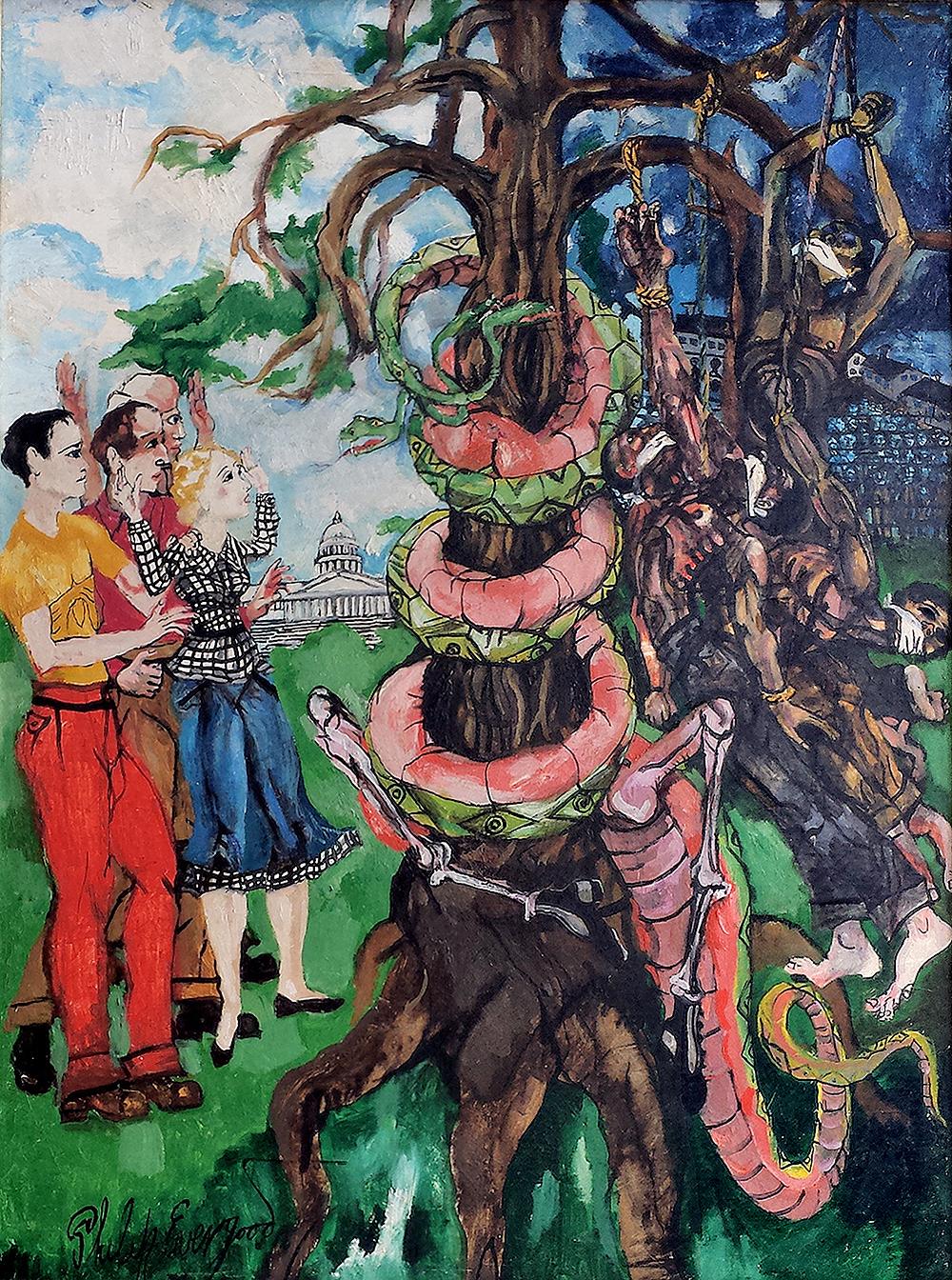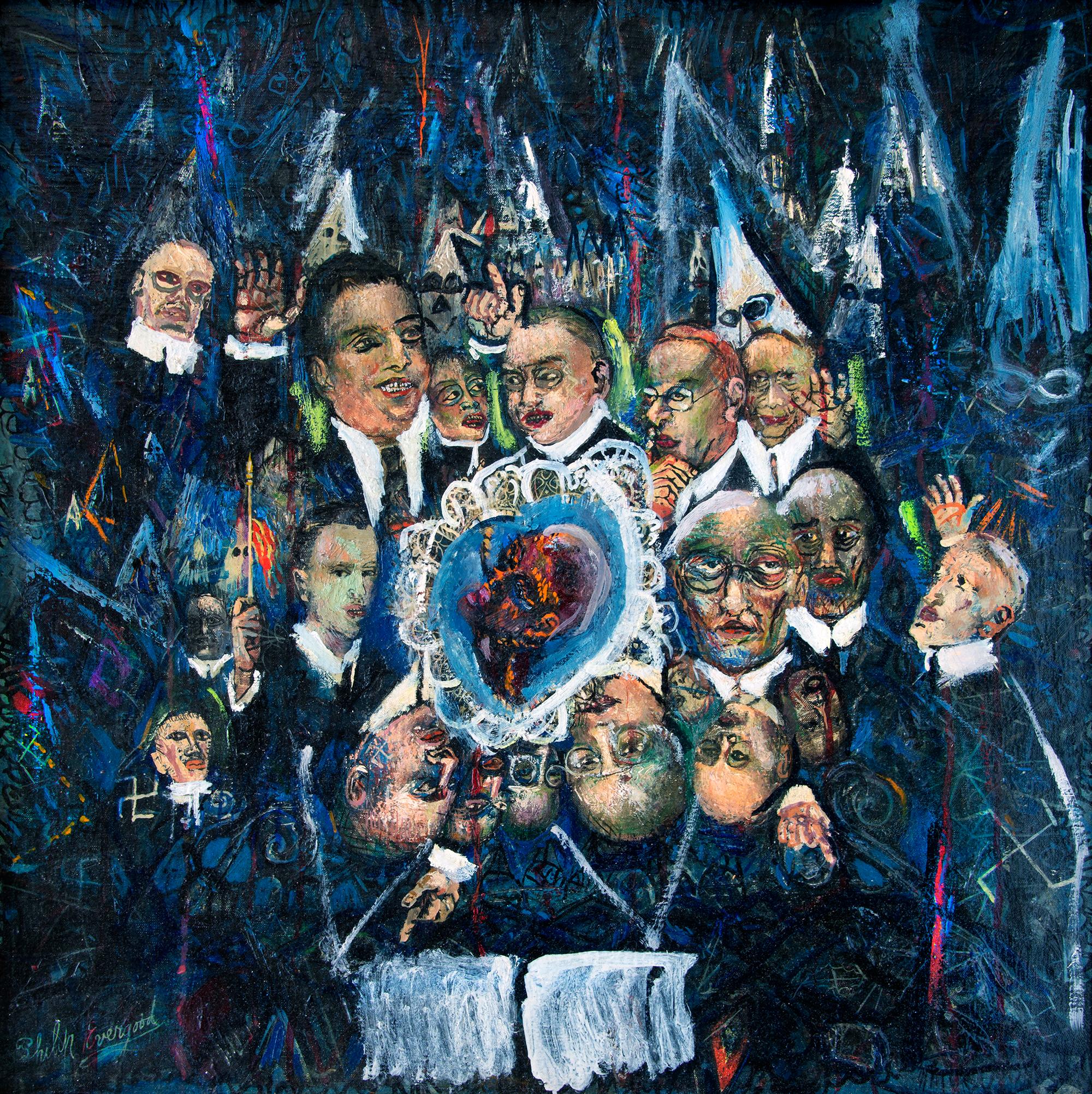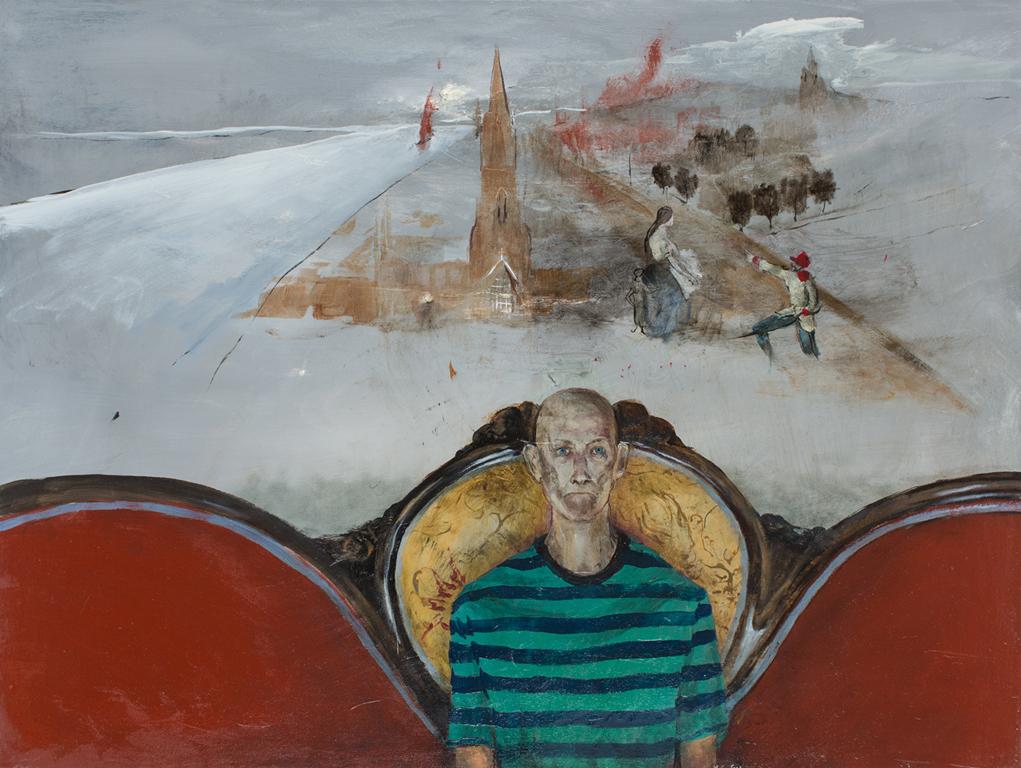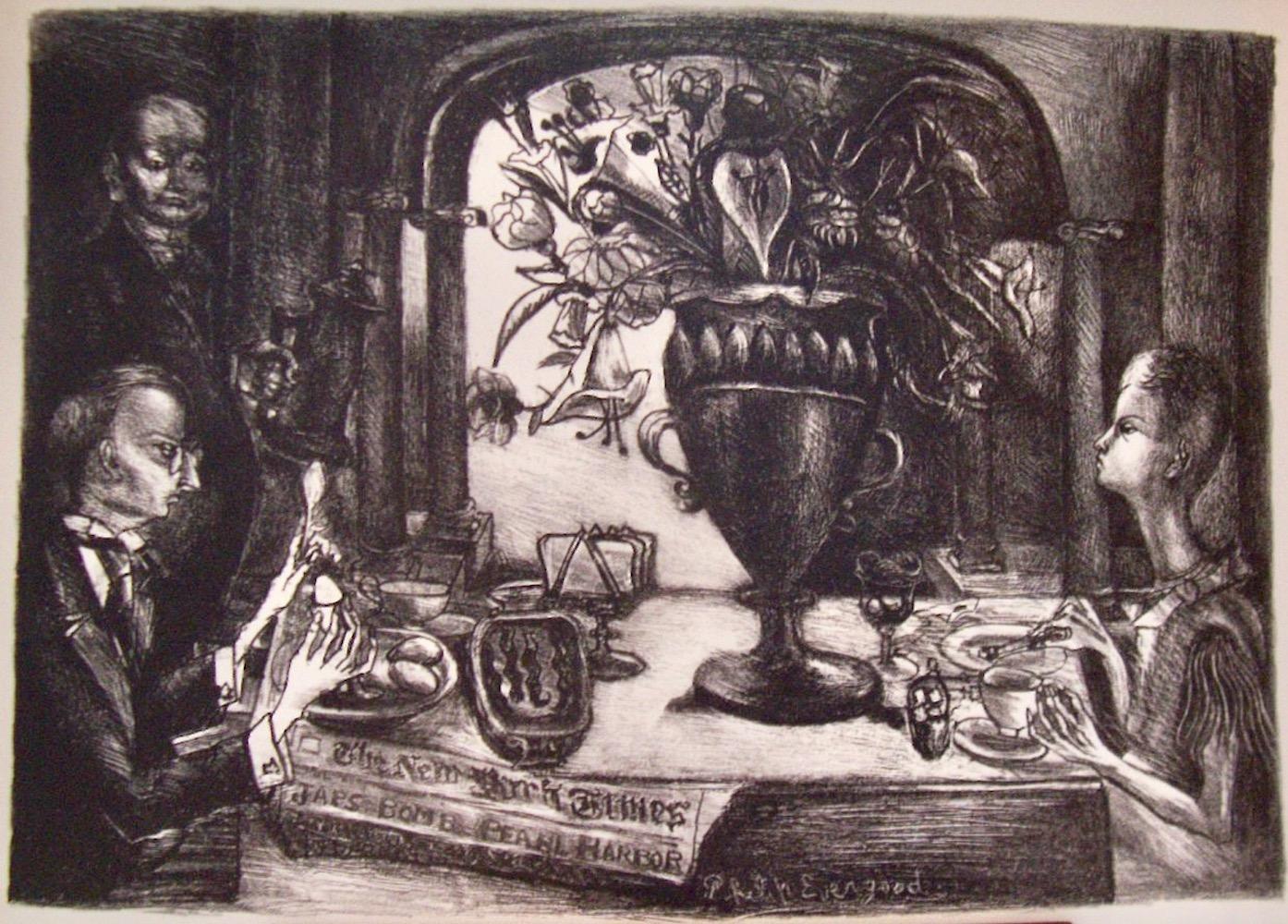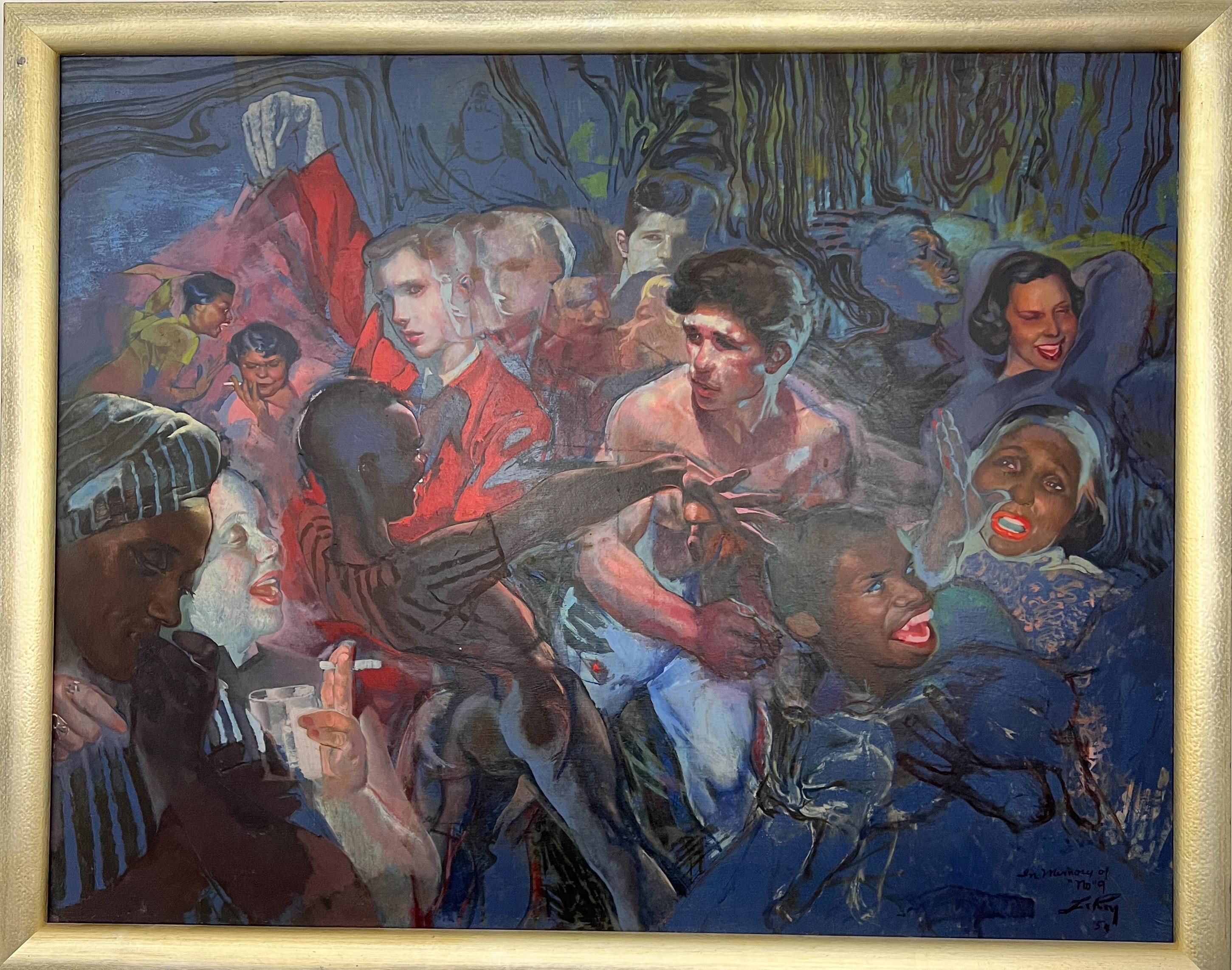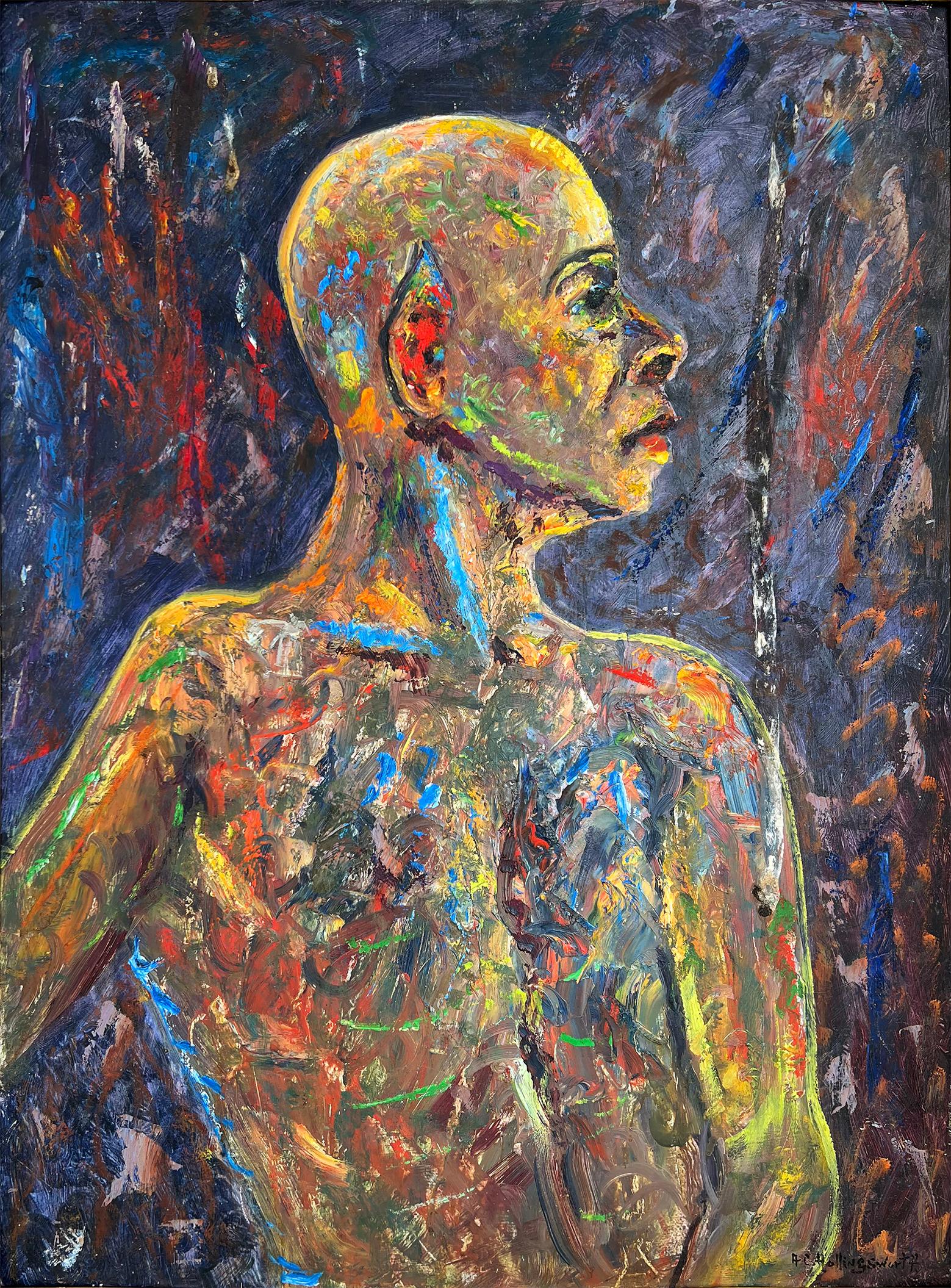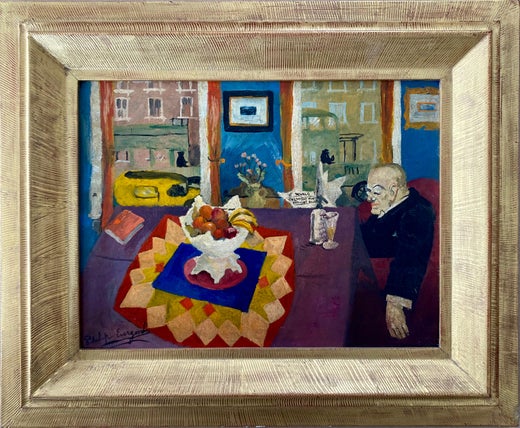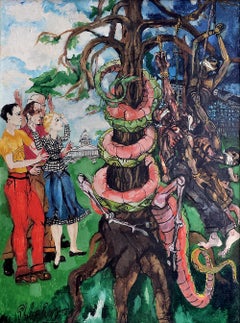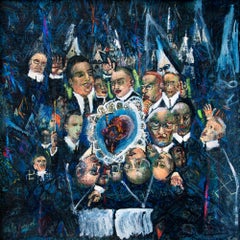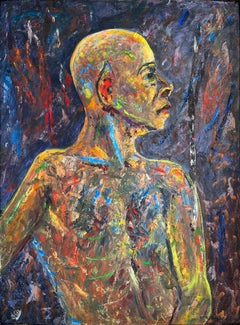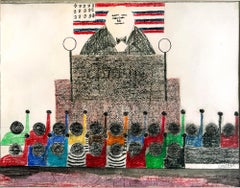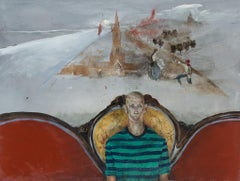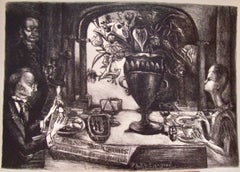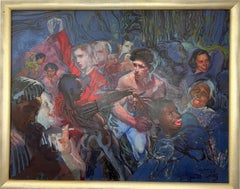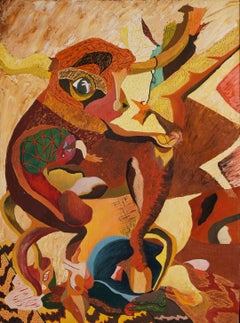Items Similar to Civil Rights, Racial Justice Little Rock
Want more images or videos?
Request additional images or videos from the seller
1 of 16
Philip EvergoodCivil Rights, Racial Justice Little Rock1955
1955
$150,000
£113,533.96
€130,732.53
CA$213,390.63
A$231,154.85
CHF 121,712.42
MX$2,805,742.31
NOK 1,517,906.88
SEK 1,435,145.36
DKK 975,956.25
About the Item
"Civil Rights." Evergood's early commentary on racial issues in the 1950s depicts four black men gagged, roped and hanging from a tree. In the background, imprisoned blacks look on through a barbed-wire fence. Whites watch in horror but do nothing to help. Meanwhile, a two-legged and three-headed serpent who symbolizes evil - wraps himself around the tree that physically and symbolically separates the races. This is an important work in the history of American art. It may be one of the very earliest examples of a major American painter doing a major work that challenges racial segregation and injustice at a time when no one else would. The title of the work is inspired by a Historic Supreme Court decision on racial segregation. The Little Rock Nine was a group of nine African American students enrolled in Little Rock Central High School in 1957. Their enrollment was followed by the Little Rock Crisis, in which the students were initially prevented from entering the racially segregated school by Orval Faubus, the Governor of Arkansas. They then attended after the intervention of President Dwight D. Eisenhower. The U.S. Supreme Court issued its historic Brown v. Board of Education of Topeka, Kansas, on May 17, 1954. Tied to the 14th Amendment, the decision declared all laws establishing segregated schools to be unconstitutional, and it called for the desegregation of all schools throughout the nation. After the decision, NAACP attempted to register black students in previously all-white schools in cities throughout the South. In Little Rock, the capital city of Arkansas, the Little Rock School Board agreed to comply with the high court's ruling. Virgil Blossom, the Superintendent of Schools, submitted a plan of gradual integration to the school board on May 24, 1955, which the board unanimously approved. The plan would be implemented during the fall of the 1957 school year, which would begin in September 1957. There are two themes that define this work. The Artist. In 1954, few white people could see American racial issues and have the courage to make a bold public stance about it. This painting is an act of bravery. It’s about Vision. It’s about Guts. The Art. Evergood was a Jewish American, fresh with the horrors of WWII in his mind. Nazi Germany exterminated Jews. Evergood felt America was exterminating Blacks. The world looked on with horror the1940’s but did not do anything. In this work, whites look on with horror do nothing. The White House and a concentration camp-like building are seen together. It’s not one black man being killed, i’s a group of blacks that are systematically killed in the same way. Imprisoned blacks, witnessing the execution as they grasp the prison bars. Are they next in line for the death gallows? Evergood is saying that this is America’s Holocaust. ACA Gallery, New York. Gallery of Modern Art, Columbus Circle New York Owen Gallery, New York
ACA Gallery, New York.
Gallery of Modern Art, Columbus Circle New York
Owen Gallery, New York
- Creator:Philip Evergood (1901-1973, American)
- Creation Year:1955
- Dimensions:Height: 30.5 in (77.47 cm)Width: 22 in (55.88 cm)
- Medium:
- Movement & Style:
- Period:
- Condition:scattered unobtrusive craquelure - colors are bright and saturated for the age of the work.
- Gallery Location:Miami, FL
- Reference Number:1stDibs: LU38538798732
Philip Evergood
Philip Evergood was an American Social Realist painter. An advocate for civil rights, much of his work depicted the daily lives of working-class people, as seen in his hallmark piece, Sunnyside of the Street (1950). “Actually if you paint a group of country folk having a feast like Brueghel did it's social painting, too,” the artist said. “But then when you get down to paintings like The Massacre of the Innocents (1566) by Brueghel when Holland was occupied by the Spanish and you have people smashing doors down and bringing out infants and cutting them in half with swords then you're doing a very brave kind of social statement.” Born Howard Blashki in 1901 in New York, NY, his father was the Australian landscape painter Miles Evergood. It was his father that anglicized the family name from the Jewish-Polish Blashki to Evergood, when Philip was a child. Moving with his parents to London in 1909, he went on to study at Eton College and Cambridge University. Set on pursuing a career in art he enrolled at the Slade School of Fine Art, studying under Henry Tonks. Returning to New York in 1923, he studied with the Ashcan School painter George Luks. During the Great Depression, the artist worked for the WPA, creating murals in both Queens, NY, and Jackson, GA. Evergood died in 1973 in Bridgewater, CT. Today, his works are included in the collections of the Art Institute of Chicago, The Museum of Modern Art in New York, the National Gallery of Art in Washington, D.C., and the Los Angeles County Museum of Art.
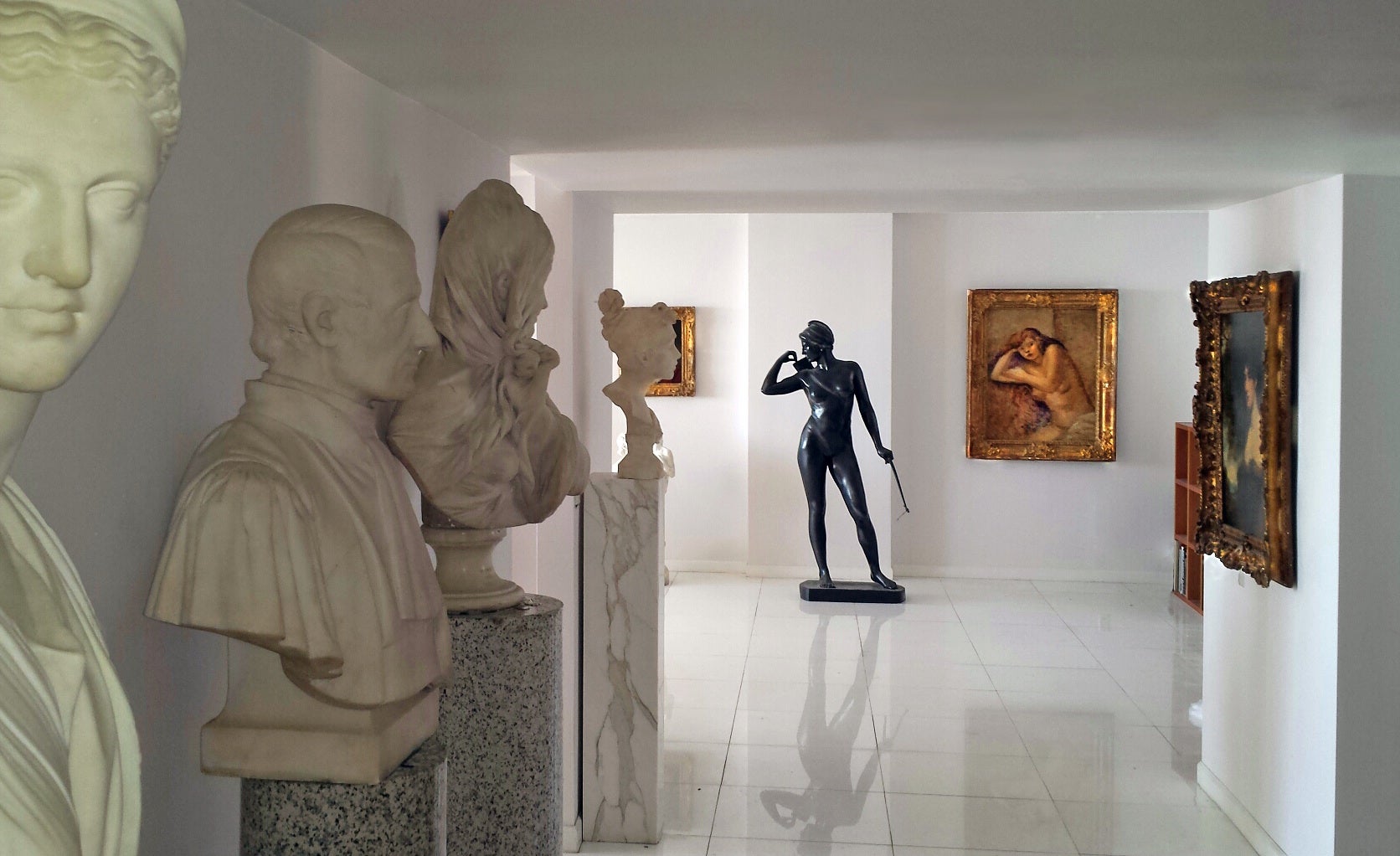
About the Seller
5.0
Vetted Professional Seller
Every seller passes strict standards for authenticity and reliability
Established in 2005
1stDibs seller since 2016
117 sales on 1stDibs
Typical response time: 1 hour
- ShippingRetrieving quote...Shipping from: Miami, FL
- Return Policy
Authenticity Guarantee
In the unlikely event there’s an issue with an item’s authenticity, contact us within 1 year for a full refund. DetailsMoney-Back Guarantee
If your item is not as described, is damaged in transit, or does not arrive, contact us within 7 days for a full refund. Details24-Hour Cancellation
You have a 24-hour grace period in which to reconsider your purchase, with no questions asked.Vetted Professional Sellers
Our world-class sellers must adhere to strict standards for service and quality, maintaining the integrity of our listings.Price-Match Guarantee
If you find that a seller listed the same item for a lower price elsewhere, we’ll match it.Trusted Global Delivery
Our best-in-class carrier network provides specialized shipping options worldwide, including custom delivery.More From This Seller
View AllPhilip Evergood, Little Rock, Oil on Canvas, 1955 - "Civil Rights."
By Philip Evergood
Located in Miami, FL
"Civil Rights." Evergood's early commentary on racial issues in the 1950s depicts four black men gagged, roped and hanging from a tree. In the background, imprisoned blacks look on through a barbed-wire fence. Whites watch in horror but do nothing to help. Meanwhile, a two-legged and three-headed serpent wraps himself around the tree that physically and symbolically separates the races. This is an important work in the history of American art. It may be one of the very earliest examples of a major American painter doing a major work that challenges racial segregation and injustice at a time when no one else would. The title of the work is inspired by a Historic Supreme Court decision on racial segregation. The Little Rock...
Category
1950s American Realist Figurative Paintings
Materials
Oil
untitled ( Civil Rights )
By Philip Evergood
Located in Miami, FL
Evergood is decades ahead of his time in shouting out against racial injustice. Painted in the late 1950's KKK is an important work. For Philip Evergood (born Philip Blashki), pain...
Category
1950s American Modern Figurative Paintings
Materials
Oil
Devil: No Horns, Burning in Hell, African American Harlem Renaissance
Located in Miami, FL
In a 1971 interview with Ebony Magazine, Alvin Hollinsworth commented on his African Jesus Christ painting, "I have always felt that Christ was a Blac...
Category
1970s Expressionist Figurative Paintings
Materials
Masonite, Oil
Black Panther Trials - Civil Rights Movement Police Violence African American
Located in Miami, FL
The Black Panther Trials - In this historically significant work, African American Artist Vicent D. Smith functions as an Art Journalist/ Court Reporter as much as a
Artist. Here, he depicts, in complete unity, 21 Black Panther Protestors raising their fist of defiance at the White Judge. Smith's composition is about utter simplicity, where the Black Panther Protestors are symmetrically lined up in a confrontation with a Judge whose size is exaggerated in scale. Set against a stylized American Flag, the supercilious Judge gazes down as the protesters as their fists thrust up. Signed Vincent lower right. Titled Panter 21. Original metal frame. Tape on upper left edge of frame. 255 . Panther 21. Framed under plexi.
_____________________________
From Wikipedia
In 1969-1971 there was a series of criminal prosecutions in New Haven, Connecticut, against various members and associates of the Black Panther Party.[1] The charges ranged from criminal conspiracy to first-degree murder. All charges stemmed from the murder of 19-year-old Alex Rackley in the early hours of May 21, 1969. The trials became a rallying-point for the American Left, and marked a decline in public support, even among the black community, for the Black Panther Party
On May 17, 1969, members of the Black Panther Party kidnapped fellow Panther Alex Rackley, who had fallen under suspicion of informing for the FBI. He was held captive at the New Haven Panther headquarters on Orchard Street, where he was tortured and interrogated until he confessed. His interrogation was tape recorded by the Panthers.[2] During that time, national party chairman Bobby Seale visited New Haven and spoke on the campus of Yale University for the Yale Black Ensemble Theater Company.[3] The prosecution alleged, but Seale denied, that after his speech, Seale briefly stopped by the headquarters where Rackley was being held captive and ordered that Rackley be executed. Early in the morning of May 21, three Panthers – Warren Kimbro, Lonnie McLucas, and George Sams, one of the Panthers who had come East from California to investigate the police infiltration of the New York Panther chapter, drove Rackley to the nearby town of Middlefield, Connecticut. Kimbro shot Rackley once in the head and McLucas shot him once in the chest. They dumped his corpse in a swamp, where it was discovered the next day. New Haven police immediately arrested eight New Haven area Black Panthers. Sams and two other Panthers from California were captured later.
Sams and Kimbro confessed to the murder, and agreed to testify against McLucas in exchange for a reduction in sentence. Sams also implicated Seale in the killing, telling his interrogators that while visiting the Panther headquarters on the night of his speech, Seale had directly ordered him to murder Rackley. In all, nine defendants were indicted on charges related to the case. In the heated political rhetoric of the day, these defendants were referred to as the "New Haven Nine", a deliberate allusion to other cause-celebre defendants like the "Chicago Seven".
The first trial was that of Lonnie McLucas, the only person who physically took part in the killing who refused to plead guilty. In fact, McLucas had confessed to shooting Rackley, but nonetheless chose to go to trial.
Jury selection began in May 1970. The case and trial were already a national cause célèbre among critics of the Nixon administration, and especially among those hostile to the actions of the FBI. Under the Bureau's then-secret "Counter-Intelligence Program" (COINTELPRO), FBI director J. Edgar Hoover had ordered his agents to disrupt, discredit, or otherwise neutralize radical groups like the Panthers. Hostility between groups organizing political dissent and the Bureau was, by the time of the trials, at a fever pitch. Hostility from the left was also directed at the two Panthers cooperating with the prosecutors. Sams in particular was accused of being an informant, and lying to implicate Seale for personal benefit.
In the days leading up to a rally on May Day 1970, thousands of supporters of the Panthers arrived in New Haven individually and in organized groups. They were housed and fed by community organizations and by sympathetic Yale students in their dormitory rooms. The Yale college dining halls provided basic meals for everyone. Protesters met daily en masse on the New Haven Green across the street from the Courthouse (and one hundred yards from Yale's main gate). On May Day there was a rally on the Green, featuring speakers including Jean Genet, Abbie Hoffman, Jerry Rubin, and John Froines (an assistant professor of chemistry at the University of Oregon). Teach-ins and other events were also held in the colleges themselves.
Towards midnight on May 1, two bombs exploded in Yale's Ingalls Rink, where a concert was being held in conjunction with the protests.[4] Although the rink was damaged, no one was injured, and no culprit was identified.[4]
Yale chaplain William Sloane Coffin stated, "All of us conspired to bring on this tragedy by law enforcement agencies by their illegal acts against the Panthers, and the rest of us by our immoral silence in front of these acts," while Yale President Kingman Brewster Jr. issued the statement, "I personally want to say that I'm appalled and ashamed that things should have come to such a pass that I am skeptical of the ability of a Black revolutionary to receive a fair trial anywhere in the U.S." Brewster's generally sympathetic tone enraged many of the university's older, more conservative alumni, heightening tensions within the school community.
As tensions mounted, Yale officials sought to avoid deeper unrest and to deflect the real possibility of riots or violent student demonstrations. Sam Chauncey has been credited with winning tactical management on behalf of the administration to quell anxiety among law enforcement and New Haven's citizens, while Kurt Schmoke, a future Rhodes Scholar, mayor of Baltimore, MD and Dean of Howard University School of Law, has received kudos as undergraduate spokesman to the faculty during some of the protest's tensest moments. Ralph Dawson, a classmate of Schmoke's, figured prominently as moderator of the Black Student Alliance at Yale (BSAY).
In the end, compromises between the administration and the students - and, primarily, urgent calls for nonviolence from Bobby Seale and the Black Panthers themselves - quashed the possibility of violence. While Yale (and many other colleges) went "on strike" from May Day until the end of the term, like most schools it was not actually "shut down". Classes were made "voluntarily optional" for the time and students were graded "Pass/Fail" for the work done up to then.
Trial of McLucas
Black Panther trial sketch...
Category
1970s American Modern Figurative Drawings and Watercolors
Materials
Watercolor, Pen, Pencil, Paper
Black Power, Attica Prison Riot Prisoners Racial Justice - African American Art
Located in Miami, FL
African American Artist Vincent D Smith makes a statement about racial justice. In this work from 1972, he depicts three African American prisoners with their faces pushed up agains...
Category
1970s Modern Figurative Drawings and Watercolors
Materials
Watercolor
Black Power Pendant - Civil Rights Movement - African American
Located in Miami, FL
For those who remember the late 1960s, viewing this painting is as much a work of art as it is a historical document of a transitional moment in American History. At the time, a Bla...
Category
1960s Contemporary Portrait Drawings and Watercolors
Materials
Paper, Ink, Watercolor, Pen, Pencil
You May Also Like
Mississippi Burning
By Miles Cleveland Goodwin
Located in Dallas, TX
In Miles Cleveland Goodwin’s soulful compositions, he narrates the story of his life. Goodwin responds to his environment, the lives of common folk living around him, and the mysteri...
Category
2010s Contemporary Figurative Paintings
Materials
Canvas, Oil
Philip Evergood, (The New York Times)
By Philip Evergood
Located in New York, NY
The ever-quirky Philip Evergood has composed a print that is at once a World War II image (The New York Times on the table has the headline 'Japs Bomb P...
Category
Mid-20th Century Ashcan School Figurative Prints
Materials
Lithograph
Mid-Century Painting of Party by African-American from Detroit.
Located in Marco Island, FL
The scale of this dynamic party painting by Leroy Foster (1925-1993) makes you feel like you are in the room with a cocktail in hand. He was an accomplished muralist, so it is no s...
Category
1950s American Modern Figurative Paintings
Materials
Canvas, Oil
20th C. Figurative Abstract Painting Cleveland School African American Artist
By Beni E. Kosh
Located in Beachwood, OH
Beni E. Kosh/Charles Elmer Harris (American, 1917-1993)
Untitled
Oil on canvas board
Estate stamped #611 verso
24 x 18 inches
Charles Elmer Harris was born in 1917 in Cleveland, Oh...
Category
20th Century American Modern Figurative Paintings
Materials
Oil
Massive Purvis Young Painting, Estate of the Artist, 84"W
By Purvis Young
Located in Lake Worth Beach, FL
Artist/Designer; Manufacturer: Purvis Young (American, 1943-2010)
Marking(s); notes: signed, BCO1FE60
Materials: painted wood
Dimensions (H, W, D): 48"h, 84"w; 50"h, 86"w frame
Additional Information: Provenance: This work is from the personal collection of Anthony Romano, one of the two guardians appointed to the artist in the later part of his life.
Purvis Young (1943–2010) was a self-taught American artist from Miami’s Overtown neighborhood, known for his raw, expressive paintings on found materials that explore themes of social justice, spirituality, and everyday urban life. His work resonates with the visual urgency of Jean-Michel Basquiat, the narrative power of Thornton Dial, and the outsider spirit of Bill Traylor and Sister Gertrude Morgan...
Category
Late 20th Century Outsider Art Figurative Paintings
Materials
Wood
"After Party", Large Scale Neo-Expressionist Abstracted Symbolist Figurative
By Michael William Eggleston
Located in Soquel, CA
"After Party", Large Scale Neo-Expressionist Abstracted Symbolist Figurative
Striking abstracted figurative titled "After Party" by Michael Eggleston (Ame...
Category
1970s Neo-Expressionist Figurative Paintings
Materials
Canvas, Oil
More Ways To Browse
Vintage Barbed Wire
Vintage Fence Wire
Prison Bar
Nyc Subway Map
Oil Paintings With Brigitte Bardot
Oil Rebbe
Oz El Hai
Packard Car
Painting Beach Swimmer
Painting Classical Rome
Painting Of Courtship
Painting Of Swimming Woman
Paintings Of Elvis
Paintings Of Paris Cafe
Parrot Watch
Pasta Painting
Paul Bunyan
Paul Goodnight
